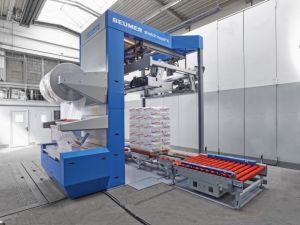Shrink hooding, stretch wrapping and stretch hooding are emerging as the most effective palletising packaging techniques on the market, and the Beumer Group is offering solutions in these areas.

Stretch hooding has been efficient in the packaging of palletised goods, with transport security, anti-theft protection, displayed characteristics of the packaged goods, and weatherproofing for outside storage all important factors. If the required stability is not provided, goods such as glass, stone or bricks stacked on trucks can detach from the palletised unit and break. Materials such as cement, flour or cocoa powder need special protection against atmospheric influences and humidity during transport and storage.
The shrinking method is particularly suited for products that are sensitive to elastic packaging stacking, such as glass. The goods are reliably protected against environmental impacts such as snow, rain, UV radiation, dust and insects. However, the shrinking process causes the film to become milky, which makes it difficult to see the packaged goods or imprinted barcodes.
Alternatively, the stretch wrapping technique is still used by many due to the low initial investment costs for machines compared with shrink or stretch hood systems. This technique, however, requires a lot of material, which means that the operator has to change the film roll frequently. This makes the technique suitable for low production rates.
Stretch hood technology is a combination of the film hood and stretch wrapping techniques. Beumer, which has its Australian headquarters in Belrose, Sydney, installed the first stretch hood system in Belgium in 1988 but the largest breakthrough for this pallet packaging technique only came about 15 years ago. The availability of improved raw materials allowed the quality of the film to increase, and, like shrink hooding, the stretch film adapts to any product that's stacked on the pallet.
The Beumer portfolio includes solutions and systems for all these packaging techniques, and considers economical, ecological and social aspects when developing its plants and systems so customers can plan their investments strategically.
The team at Beumer compared shrink hooding to stretch hooding and found a clear cost advantage for the stretch method. They took a palletised stack of 1630 millilitres in height for test purposes. Systems that use shrink hooding to package palletised items can process 35 to 70 pallets per hour. With this process, the film strength lies between 120 and 180 micrometres. By using the stretch hooding method, throughput is nearly doubled, with 100 to 120 pallets per hour. The film used is also thinner, and less material is required due to the elasticity of the film.
The Beumer Stretch Hood is the result of an intralogistics specialist from Beckum redesigning its tried-and-trusted packaging system from scratch. During its development, specialists analysed various components and optimised them in terms of function, arrangement and ergonomics.
Beumer provides the operator with an online configurator to calculate and evaluate the economic efficiency of different packaging techniques, as well as the added value for their company. The team creates a presentation that is individually tailored to the customer's requirements so they receive a reliable comparison between the different packaging methods, the individual energy consumption, and the maintenance, investment and system costs.





